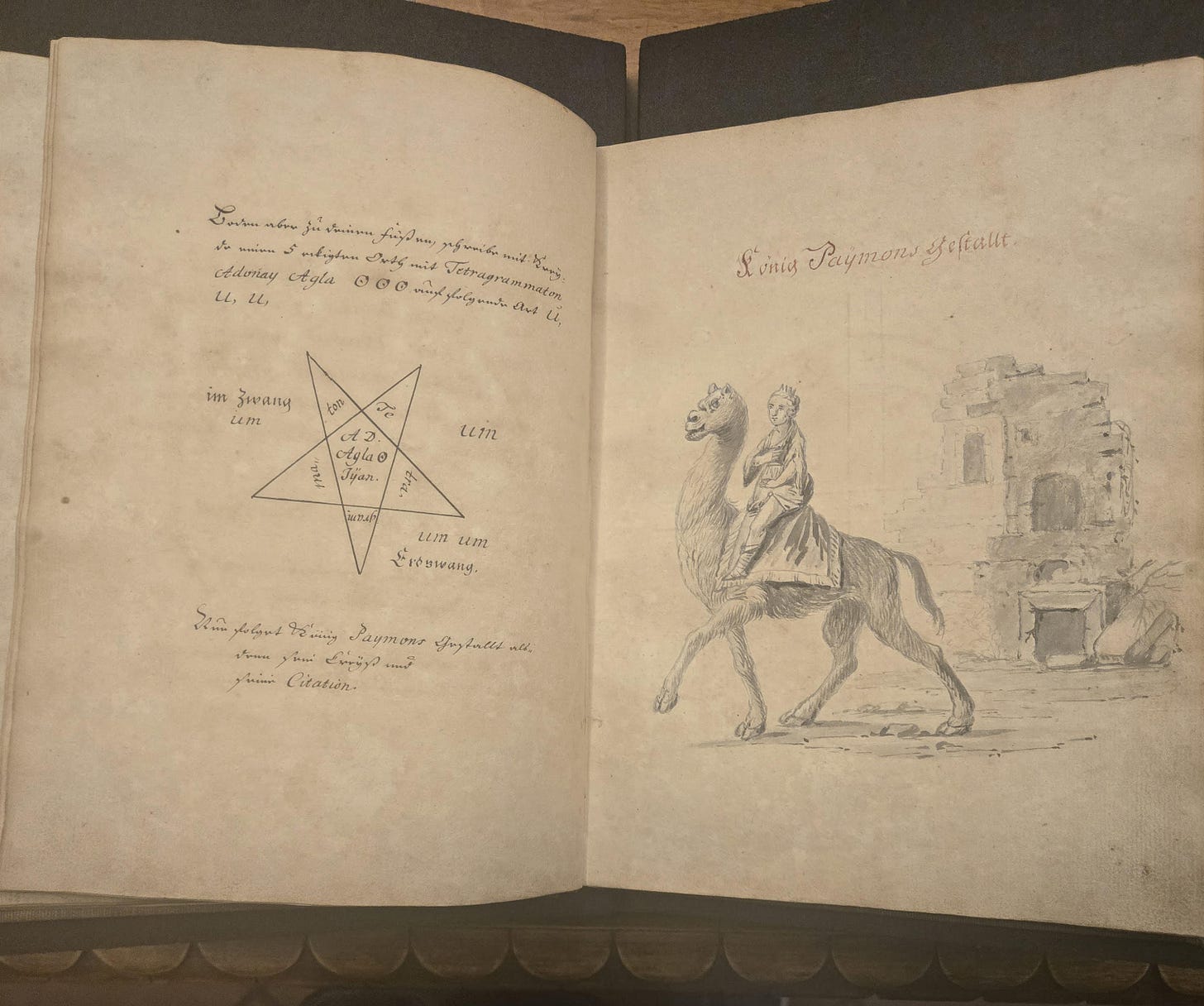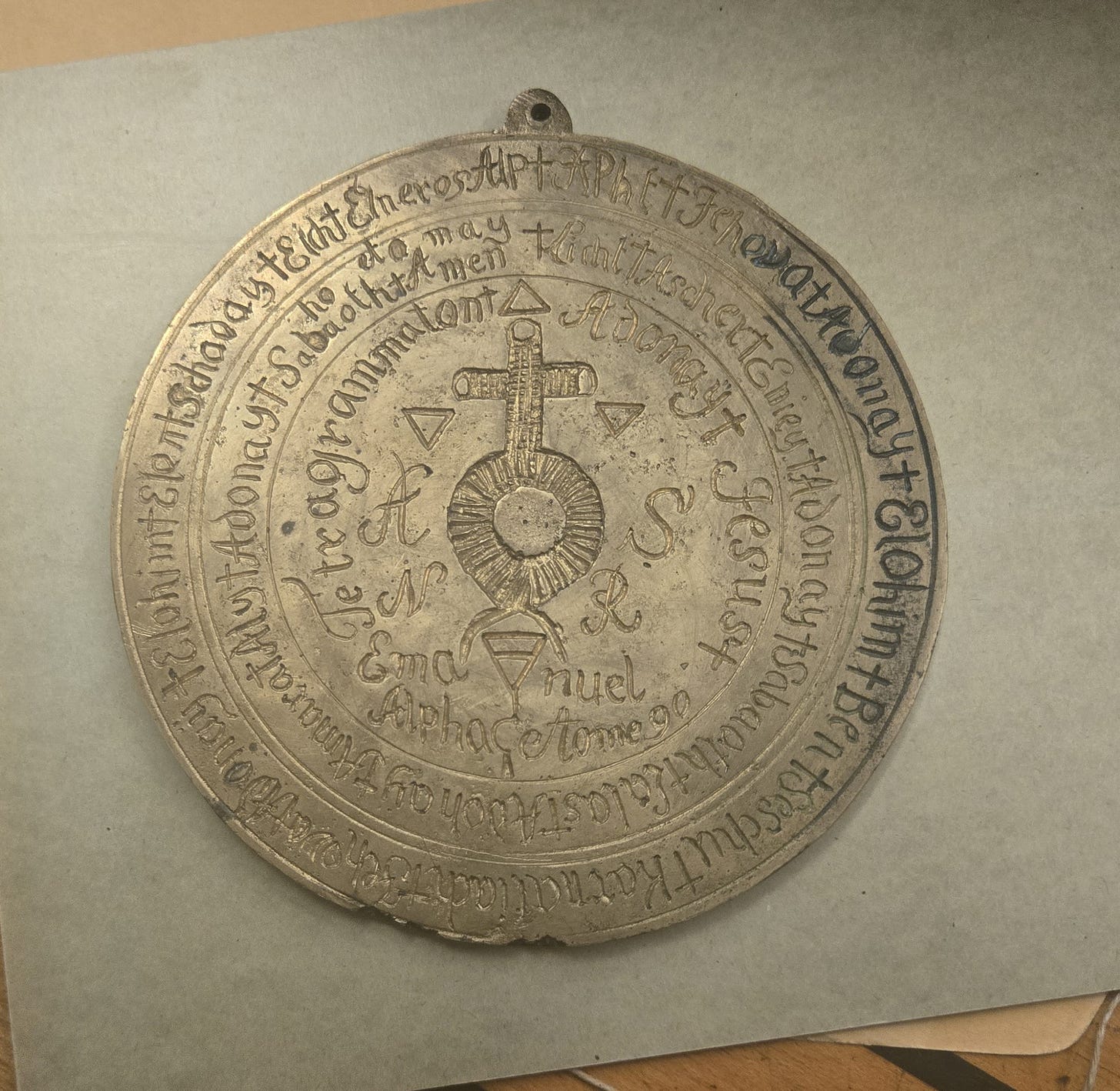Interview with an Archivist
Witches, Witchcraft, and the Art of Curation
As a writer and historian, I ask all kinds of questions about the archival materials I’m researching: what are these materials, who created them, how were they used, how are they connected (or not) to each other, and why and how have they survived the ravages of time? To name just a few. The questions are seemingly endless!
Over the years, I’ve found myself wondering what it must be like to explore archives from the other side of the help desk. Archival librarians, to my mind, have one of the coolest jobs in the world, researching, cataloging, caring for, and curating objects from across time and land. If I weren’t a historian, I would have loved to have been an archivist!
This week I finally got a chance to glimpse into the life of a working archivist by interviewing Malika Desire, an art historian and reference archivist within the Manuscripts, Archives and Rare Book Division at the New York Public Library - one of my favorite places on earth. I reached out to her, because this fall, she curated for the NYPL a display case on witches and witchcraft. The brilliant and spooky display brought a fascinating, diverse array of witchy materials together to show how rare archival objects can speak to each other in surprising ways, while helping to shed light on an understudied area of history.
In the interview below, I asked Malika about what she loves most about her work as an archivist, her favorite reference question ever received, and of course, what it was like to curate the witchy display case. Photos included!
Library of Wonders: What do you love most about being an archivist?
Malika: What I love is the collection materials themselves. As the newest addition to my division, I am in an endless pursuit of discovering more about what our division holds. Every day, I am introduced to new collection materials through our patrons’ varied research interests. I have seen incredibly old objects, such as our cuneiform tablets, which were brought up to the reading room for a patron. They are by far some of the oldest items I’ve had the opportunity to see and handle. However our collection is extremely vast in both formats and date range; I have come across materials as recently as 2019, such as Sabrina Cintron’s, The Witches’ Grimoire. This comic began as a series of character designs for the global 2018 Inktober drawing challenge and developed into a short comic book. Every day is a new discovery, and what better way to spend five days a week!
LoW: What makes the NYPL archives stand out?
Malika: Accessibility! What makes NYPL so unique is that it is still a public library. With access in mind, my division, the Manuscripts and Archives, aims to both ensure the preservation of our collection, and to be access-forward. We are always aiming to find ways for our patrons to view their desired materials. And who can these researchers be? It can be anyone. You needn’t be a scholar pursuing their PhD or a seasoned researcher. You can be a high school student interested in witchcraft or an artist looking to be inspired.
LoW: What is your favorite question you’ve ever received from a researcher?
Malika: My favorite reference inquiry was one of the first complicated inquiries I encountered when I started my position. It was from a French student inquiring about our New York Custom House Records. Their inquiry concerned the deportation of 1,500 to 2,000 Guadeloupean soldiers in 1802 who were abducted and conducted to Brest after failing to be sold in Cartagena and New York, under the orders of Napoleon Bonaparte’s generals. During their time in the New York port, their presence in a squadron of several French frigates loaded with former Black soldiers caused great upheaval. What made this inquiry so interesting was the fact that this was a period of time that I personally specialized in; my own research follows this period and these regions. Not only had I never heard of these events, but I was surprised to not find much material concerning them. The reference inquiry required me to dig thoroughly, and while our collection did not hold materials related to this conflict, it led to an enriching research process. I was able to discover more about my division holdings of naval logbooks and dive deeper within the Custom House records. I was ultimately able to find newspaper articles concerning the events through NYPL’s access to America’s Historical Newspapers database. This experience shaped some of my founding principles as a reference archivist: we aim to help our researchers as much as we can, even if it is just pointing them in the right direction.
LoW: Let’s discuss the display case you recently curated on witches and witchcraft. What did it include, and how did you decide which objects to display?
Malika: My display case was inspired by my own personal connection to witches and witchcraft. I aimed to create a case that both highlighted the range of materials my division held concerning the subject matter and ultimately uplifted a community and identity that exists and still continues to grow. With these goals in mind, I decided to structure my case to showcase society’s ever-evolving perception of witches and witchcraft. With this organization, my display case was able to feature an array of materials, some dating as far back as the 1400s to as early as 2019. Each item selected exemplified one of the four perspectives presented in the case: fear, fascination, solidarity, and empowerment. Some highlights are a copy of Cotton Mather’s The Wonders of the Invisible World: Being an Account of the Tryals of Several Witches, a photograph of the witch of Positano Vali Myers, and a 1978 copy of Sabrina the Teenage Witch #49.
Miracul Kunst-und-Wunder-Buch, with medal, 18th century, Magic miscellaneous collection, Manuscripts and Archives Division
LoW: What’s your favorite object in the display?
Malika: My current favorite is a peculiar volume titled Faustens, D. Johannis. Miracul Kunst-und-Wunder-Buch, bearing the date Passau, 1612. Despite its claimed publication date, this rare magical manuscript is a fictitious work likely produced in the late 18th century. It draws inspiration from the legendary figure Johann Georg Faust, who historically died in 1540. What I find most compelling is not only the manuscript’s fantastical content but also the fascinating way it manipulates historical context and dating to create an aura of authenticity. It also was accompanied by a very cool medallion with markings carved into it. Beyond the fascinating nature of the object, the story surrounding my discovery of it aids my favoritism. The night before I discovered this manuscript, one of my siblings was watching the film Hereditary. The day I discovered the volume, the first page I opened up to was none other than an image of Paimon! Imagine my surprise that the very demon terrorizing the family in Hereditary showed up at my job. A bit spooky!
Miracul Kunst-und-Wunder-Buch, with medal, 18th century, Magic miscellaneous collection, Manuscripts and Archives Division
LoW: What questions popped up for you while you were creating this display? Were any of them unanswerable?
Malika: There were quite a few questions that popped up during the curation of my display case. Some were founding questions like scope, locations, and formats. These questions had to be answered very early on as the display case I was working with was relatively small, but the history of witches and witchcraft was an immense topic. I ultimately decided the scope of the material would be from the medieval period to now and not focusing on the European witch hunts but the United States. Other questions were more nebulous, like how to best represent and include the community of modern witches. With the help of my colleagues, I feel like I answered all questions concerning the case.
Miracul Kunst-und-Wunder-Buch, with medal, 18th century, Magic miscellaneous collection, Manuscripts and Archives Division
LoW: Any tips you have for people who want to visit the NYPL archives to conduct research of their own?
Malika: To make a trip to the Manuscripts, Archives and Rare Books division as successful as it can be, I suggest creating a Special Collections account and requesting an appointment online in advance. This would allow our team to ensure your requested materials are ready and available for your arrival. Lastly, ask questions! Always feel free to email us at manuscripts@nypl.org with any questions.
More about Malika Desire: Malika serves as a Reference Archivist within the Manuscripts, Archives and Rare Book Division at NYPL and is an active art historian. Her academic and professional journey centers on exploring the intersection of cultural institutions, resources, and the production of silences in historical narratives. Her work emphasizes re-contextualizing established narratives in collections across libraries, museums, and archives to foster diversity in the production of knowledge. Through her art historical research, she critically assesses collecting practices from a post-colonial perspective, prioritizing non-Western narratives to offer alternative approaches to organizing cultural institutions.




